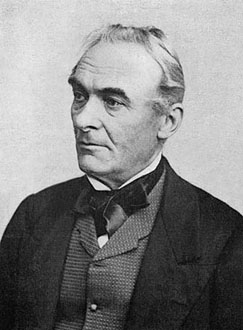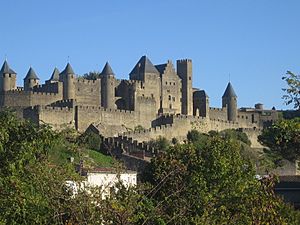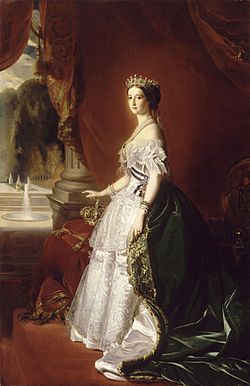Prosper Mérimée facts for kids
Quick facts for kids
Prosper Mérimée
|
|
|---|---|
 |
|
| Born | 28 September 1803 Paris, France |
| Died | 23 September 1870 (aged 66) Cannes, France |
| Literary movement | Romanticism |
| Notable works | La Vénus d'Ille (1837) Carmen (1845) |
| Parents | Léonor Mérimée (father) |
| Relatives | Augustin-Jean Fresnel (cousin) Fulgence Fresnel (cousin) Jeanne-Marie Leprince de Beaumont (great-grandmother) |
| Signature | |
Prosper Mérimée (born September 28, 1803 – died September 23, 1870) was a famous French writer. He was part of the Romanticism movement. He helped create the "novella" style, which is a story longer than a short story but shorter than a novel.
Mérimée was also an important archaeologist and historian. He played a big role in saving old buildings and monuments in France. He is best known for his novella Carmen. This story later became the basis for Bizet's famous opera Carmen.
He loved the Russian language and learned to speak it well. He translated works by important Russian writers like Pushkin and Gogol into French. From 1830 to 1860, he worked as the inspector of French historical monuments. He helped protect many historic places. These include the medieval city of Carcassonne and the Notre-Dame de Paris cathedral. He also helped discover the famous The Lady and the Unicorn tapestries. He made sure they were saved. The official list of French monuments, the Base Mérimée, is named after him.
Contents
Early Life and First Writings
Prosper Mérimée was born in Paris, France, on September 28, 1803. His father, Léonor, was a painter and a professor. His mother, Anne, was also a painter. Prosper had a talent for languages. By age fifteen, he spoke English very well. He also learned ancient Greek and Latin. Later, he became fluent in Spanish and could speak Serbian and Russian.
He studied law, but his real passion was literature. In the 1820s, he met many famous writers in Paris. One of his closest friends was Henri Beyle, who later became known as Stendhal. Mérimée also joined the new Romanticism movement in art and literature.
In 1825, he published his first work, Théâtre de Clara Gazul. These were short plays that seemed to be written by a Spanish actress. They were actually clever comments on French society and politics. Famous writer Balzac called it "a big step in the modern literary revolution."
In 1827, he published La Guzla. This book pretended to be a collection of poems from an ancient region called Illyria (modern Croatia). The poems were very romantic and featured ghosts and werewolves. Mérimée later admitted that most of the poems were not real. Even so, the book made him an important literary figure. His stories and articles then appeared regularly in top literary magazines.
He also wrote three traditional novels. One was La Chronique du Temps de Charles IX (1829). It was a historical novel set in the 16th century. It included a detailed and bloody scene of the St. Bartholomew's Day massacre.
Novellas and Travels to Spain
In 1829, Mérimée found a new writing style that suited him perfectly: the novella. This is a long short story or a short novel. He wrote thirteen novellas between 1829 and 1834. His style was clear and simple, without unnecessary flowery language. The stories often had a sudden and dramatic ending.
Two of his most famous novellas from this time are Mateo Falcone and Tamango. Mateo Falcone is a tragic story about revenge in Corsica. Tamango is a drama set on a slave-trading ship. Both were very popular.
Mérimée also began taking long trips. These travels gave him ideas for many of his future stories. In 1830, he traveled to Spain. He spent time in museums, watched bullfights, and studied old buildings. While in Spain, he met Cipriano Portocarrero and his wife, the Countess of Montijo. He also met their young daughter, Eugénie, who was four years old. Eugénie later became Empress Eugénie, the wife of Emperor Napoleon III.
When he returned to Paris, he published exciting stories about his trip to Spain. These included the first mention of Carmen. The Countess of Montijo had told him this story.
Inspector of Historical Monuments
On May 27, 1833, Mérimée was named Inspector-General of historical monuments. This job fit his interests perfectly. Many of France's old buildings, especially churches, had been damaged or destroyed during the French Revolution. The government wanted to restore them. Mérimée became the second Inspector, and he was very active in this role for 27 years.

Mérimée was very organized. He put together a team of architects who specialized in restoration. Between 1834 and 1852, he made 19 inspection tours across France. He described and listed the monuments he saw. He also wrote scholarly studies and popular books about France's monuments.
In 1840, he published the first official List of Historic Monuments in France. It had 934 entries. By 1848, this list grew to 2,800. He created a system to decide which restoration projects were most important. He also set up a network of people in each region to watch over the projects and report any damage.
Even though he was an atheist, he protected and restored many churches. He saw them as works of art and important parts of national history. He often argued with local officials who wanted to tear down or change old buildings. He used his power to stop the city of Dijon from turning a medieval palace into an office building. He also prevented Avignon from destroying its medieval walls for railroad tracks.

He worked with the architect Eugène Viollet-le-Duc on several projects. Viollet-le-Duc helped prevent the collapse of the medieval Vézelay Abbey. He also restored the Notre-Dame de Paris Cathedral, putting back statues and restoring the spire. Mérimée told his restorers to avoid making up new parts. He wanted them to reproduce what clearly existed or copy similar styles from other buildings.
In 1840–41, Mérimée traveled to Italy, Greece, and Asia Minor. He visited and wrote about ancient sites. His work in archaeology earned him a spot in the French Academy of Inscriptions and Belles-Lettres. His stories also won him a seat in the Académie française in 1844.
In 1842, he arranged for the French government to buy a medieval building, the Hôtel d'Cluny. He oversaw its joining with Roman bath ruins and the collection of medieval art. This museum, now called the National Museum of the Middle Ages, opened in 1844.
In 1841, during an inspection tour, he stayed at the Château of Boussac, Creuse. With writer George Sand, he found the six tapestries of The Lady and the Unicorn. They were in bad condition, but Mérimée and Sand immediately knew how valuable they were. Mérimée had them listed as monuments and arranged for their care. Today, these tapestries are displayed in the National Museum of the Middle Ages.
Famous Novellas: Venus d'Ille, Colomba, and Carmen
While working as an inspector, Mérimée wrote three of his most famous novellas. These are La Vénus d'Ille (1837), Colomba (1840), and Carmen (1845).
The Venus d'Ille was inspired by his 1834 tour. It tells the story of a statue of Venus that comes to life and kills a man. Mérimée believed that when writing about supernatural things, you should include many realistic details.
Colomba is a sad story about revenge in Corsica. The main character, Colomba, convinces her brother to kill a man to avenge their family. This story came from his long trip to Corsica. It is full of details about Corsican culture. When it was published, it was very popular. It is still studied in French schools today.
Carmen was based on a story the Countess of Montijo told him in 1830. It is about a beautiful Romani (gypsy) girl who robs a soldier. The soldier falls in love with her. He kills another man out of jealousy and becomes an outlaw. Later, he kills Carmen because she falls in love with someone else. Carmen became truly famous in 1875, after Mérimée's death. This was when Georges Bizet turned it into a famous opera.
Later Years and Russian Literature
In 1847, Mérimée started learning Russian. He wanted to read the works of Alexander Pushkin in their original language. By 1848, he could translate Pushkin's The Queen of Spades into French. He also translated other Pushkin stories and works by Nikolai Gogol. He wrote essays on Russian history and literature.
In February 1848, Mérimée saw the French Revolution of 1848 happen in Paris. This revolution removed King Louis Philippe and created the French Second Republic. Mérimée kept his job as Inspector of Historic Monuments. In 1849, he helped save the medieval Citadel of Carcassonne.
In 1852, Mérimée faced a difficult time. His mother, with whom he lived, passed away. He also got into trouble for defending a friend who was accused of stealing old manuscripts. Mérimée was sentenced to fifteen days in prison and fined. He served his time in a historic monument, the Palais de la Cité prison.
Advisor to the Empress and Senator

In 1852, Louis-Napoleon Bonaparte became Emperor Napoleon III. Mérimée accepted this change. He was promoted and kept his position as Inspector of Historic Monuments.
Mérimée soon became very close to the Emperor's wife, Empress Eugénie. She was the young daughter of his friends, the Count and Countess of Montijo. In 1853, she married Napoleon III. Mérimée was made a Senator and became a trusted friend to the Empress.
He often traveled with the imperial court. He told stories, acted in plays, and helped organize discussions for the Emperor with important French cultural figures. He also met famous visitors like Otto von Bismarck.
Mérimée spent little time on his role as Senator. He had planned to write a big book about Julius Caesar. However, the Emperor decided to write his own book about Caesar. Mérimée had to give the Emperor all his research and help him write the book.
Final Works and Death
Mérimée made his last long tour of monuments in 1853. He continued to be the chief inspector until 1860. He wrote his last three novellas in the fantasy style. Lokis was a horror story about a creature that was half-man and half-bear. He read it aloud to the Empress and the court, but it was quite shocking.
He continued to work for monument preservation. He also kept developing his love for Russian literature. He wrote a series of articles about the life of Peter the Great. He believed Russian was "the most beautiful language in Europe."
In the 1860s, his health worsened. He had serious breathing problems and spent more time in Cannes, in the south of France. He became more traditional in his political views.
The war between Prussia and France began in May 1870. Mérimée returned to Paris for emergency meetings. His health continued to decline. On September 2, news arrived that the French army had surrendered and Napoleon III was captured. On September 4, the Third Republic was declared. Mérimée tried to see the Empress, but she had fled to London.
Mérimée returned to Cannes and died there on September 23, 1870, just before his 67th birthday. He was buried in the Protestant cemetery in Cannes. A few months later, during the Paris Commune, a mob burned his Paris home. They destroyed his library and notes because of his connection to the Emperor.
Literary Impact
Mérimée's most famous work is Carmen. It is known mainly because of the opera by Georges Bizet. He is also seen as a pioneer of the short story and novella. His novellas are still widely taught in French schools.
Mérimée was an important figure in the Romantic movement. He used colorful and exotic places like Spain and Corsica in his stories. He often wrote about fantasy and supernatural themes. His stories often featured strong emotions, violence, and usually ended tragically. He told his stories with a certain distance and ironic tone.
His skill in writing the novella was a big contribution to French literature. He wrote with few words and focused on the action. A critic once said, "his story is clear, lean, alert, vivid." He is considered a predecessor to writers like Guy de Maupassant.
Mérimée's other important legacy is the system he created for classifying historical monuments. He saved many major sites, including the walled city of Carcassonne. He also helped create the National Museum of Medieval History in Paris. The French national list of heritage monuments is named the Base Mérimée in his honor. His discovery and preservation of The Lady and the Unicorn tapestries are also part of his lasting impact.
Many of Mérimée's works have been adapted into films and television shows.
Works by Prosper Mérimée
Plays
- Théâtre de Clara Gazul – short satirical plays (1825)
- La Jacquerie, scènes féodales – plays about a peasant revolt in the Middle Ages (1828)
- Le carrosse du Saint-Sacrement – a comedy about a theater group (1829)
Poems
- La Guzla – ballads supposedly translated from Croatian (1827)
Novels
- La Chronique du temps de Charles IX – a novel set during the St. Bartholomew massacre (1828)
Novellas (Long Short Stories)
- Mateo Falcone – about a Corsican man who kills his son for justice (1829)
- Tamango – about the slave trade (1829)
- La Vénus d'Ille – a horror story about a bronze statue that comes to life (1837)
- Colomba – about a young Corsican girl who pushes her brother to seek revenge (1840)
- Carmen – about a Romani girl killed by the soldier who loves her (1845). This became the basis for Bizet's opera.
- Lokis – a horror story set in Lithuania, about a half-man, half-bear creature (1868)
- La Chambre bleue – a supernatural tale written for the Emperor's court (published after his death)
- Djoûmane – his last novella (published after his death, 1870)
Translations of Russian Literature
- La Dame de pique (The Queen of Spades) by Alexander Pushkin (1852)
- L'Inspecteur général (The Government Inspector) by Nikolai Gogol (1853)
- Apparitions by Ivan Turgenev (1866)
Letters
- Lettres à une inconnue (Letters to an unknown) – a collection of letters to Jenny Dacquin (1874)
See also
 In Spanish: Prosper Mérimée para niños
In Spanish: Prosper Mérimée para niños

